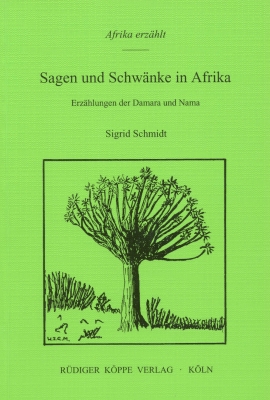
Sagen und Schwänke in Afrika
Erzählungen der Damara und Nama
Author: Sigrid Schmidt.
Series: Afrika erzählt Volume 5
1997245 pp.
Text language(s): German
Format: 155 x 230 mm
520 g
Paperback
€ 34.80
Buy 'Sagen und Schwänke in Afrika' as a downloadable PDF document directly from our online shop »
Order 'Sagen und Schwänke in Afrika' as print edition »
The author has already described tales, fables, and premaeval stories in four volumes of the series Afrika erzählt. In the present work she concentrates on the ‘real’ stories, the legends and merry tales. For the first time the attempt is made to give a cross-section through the legends of an African ethnic group, and to capture the huge scope from the dark to the ridiculous, from the descriptive to the preaching. No other narrative form reveals so much about the Namibian people, and their feelings, beliefs, and thoughts today.
The contents include entertaining ghost stories, but also acutely felt personal experiences with – from our point of view – supernatural beings. All 71 texts are accurately translated in a fluent legibility from the author’s cassette recordings, and they illustrate the distinct atmospheres and ways of telling. Finally a description of two narrative evenings is included:
„Lass nur!“ / Der Mann ohne Kopf / Die ermordete Frau / Der Besuch der toten Mutter / Der Tanz mit dem Spuk / Der Tote rächt sich / Menschenknochen / Das Nachtquartier / Die beiden toten Frauen / Der Postträger / Der Besuch auf der Farm / Das verlassene Haus / Der Tod der Großmutter / Der Sarg auf meinem Auto / Die verhaltenen Winde / Nanahes und das Meer / Wie Orte ihren Namen erhielten: a) Farm Maguams, b) Felsrest Mukorob, c) Bergkuppe Hauneib / Du musst erst mit diesem Ort sprechen (Tsekhom): a) Die Khanigukha-Berge bei Rehoboth, b) Die Ockergrube und das Wasser der Großen Schlange, c) Die Wasserstelle im Khomashochland, d) Das Meer begrüßen / Der starke Mann O!garob / Der wilde Mann / Wie meine Mutter Hai-hab entkam / Der Mann, der Springbockeuter überkochen ließ / Ein Beutel voll Dunkelheit / Das Ehepaar und der Regen / Der junge Mann und der Wind / Der dumme Mann / Das freche und das stehlende Mädchen / Ungehorsame Jägersfrauen / „Opa, hier kommt ein großer Hund!“ / Der sparsame Vater / Das eingemauerte Kind / Der Hund in Pastors Garten / Die Katze / Die Katze und die Fettkuchen / Die alte Frau, die sich immer in Tiere verwandelte / Die ausgesetzte Großmutter und die Hyäne / Die Buschmannfrau, die Löwin wurde / Der Alte, der aus dem Holz herauskam / Die Buschleute im Gefängnis von Omaruru / Die Zaubermuschel / Die alte Heiden-Großmutter / Der faule Lukas und der Engel Gabriel / Wie schmuggelt man Gewehre? / Die redenden Stachelschweine / Der singende Pau / Die krähende Hühnerdiebin / Das Kind unter den Pavianen / Als ich unter den Pavianen lebte / Der Mann, der einen Löwen als Hund verkaufte / Ein ganz besonderer Hund / Der Honigdachs und der Honigdieb / Katzen sind unheimlich / Die Ziege ist weg / Die halbierte Schlange / Mambas und der Tod / Das Kind und die Schlange / Der Liebhaber im Sack / Das Mädchen und die Schlange / Beinahe hätte die Große Schlange mich gefangen / Die Große Schlange wird getötet / Die fliegende Schlange / Die Schlange aus dem Himmel / Turos / Die Klippdachs-Schlange und die Weiße Schlange / Der Ovambo und die schwarze Schlange / Meine Erlebnisse mit der Großen Schlange vom Oranje / Großmutter Has / Tokolossi / Von Gift und Tokolossis / Die beiden Hyänenjäger (Nama und Deutsch) / Okombahe – Agommes – Nassschenkel (Nama und Deutsch).
In the second part the reader can find background information about the narrators and the circulation of the legends.
It shows that different African subject matters are already known in Europe, and are even found in our newspapers as “true incidents” in our neighbourhoods. The third part examines the nature of the African legends, their relation with tales and merry tales, the crucial points in their contents, and their relation with life, and belief traditions of the narrators.
In her Catalogue of the Khoisan Folktales of Southern Africa, re-edited in 2013, Sigrid Schmidt lists all tales which were told by Khoisan people and said to have been learned orally. The catalogue consists of two volumes that can be ordered separately or together, see the following links:
Accompanying material:
- Catalogue of the Khoisan Folktales of Southern Africa
(ISBN 978-3-89645-870-4 ) - Catalogue of the Khoisan Folktales of Southern Africa
(ISBN 978-3-89645-871-1 ) - Catalogue of the Khoisan Folktales of Southern Africa
(ISBN 978-3-89645-872-8 ) - Hänsel und Gretel in Afrika
(ISBN 978-3-89645-123-1 ) - Scherz und Ernst
(ISBN 978-3-89645-122-4 ) - Tricksters, Monsters and Clever Girls
(ISBN 978-3-89645-128-6 )
Cross-reference:
| « back | Print version | [top] |
 Books
Books Audio
Audio Biographies
Biographies Series
Series Festschrifts
Festschrifts Journals
Journals